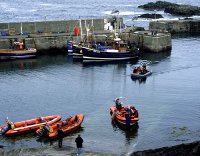 |
|
|||||||||||||||||||||||||||||||||||||||||||||||||||||||||||||||||||||||||||||||||
|
||||||||||||||||||||||||||||||||||||||||||||||||||||||||||||||||||||||||||||||||||
|
|
||||||||||||||||||||||||||||||||||||||||||||||||||||||||||||||||||||||||||||||||||
|
||||||||||||||||||||||||||||||||||||||||||||||||||||||||||||||||||||||||||||||||||
|
Although the shore diving is some of the best in the UK, there are many other excellent sites that can only be reached by boat. These range from the very sheltered but stunningly colourful surge gullies that run deep into St. Abbs Head on the NW side of the lighthouse to a variety of scenic drift dives. Typical of these is Anemone Gully (deservedly the most popular boat dive in the area) and the Black Carrs, just minutes across the bay from St. Abbs harbour. Although these sites can be busy on some weekends, there are others just as good which hardly get dived at all. One such dive is known as The Horn, a spectacular and extensive steep sided ridge of rock about 400m directly out to sea from the harbour. And don't overlook the fact that there is more excellent diving off Fast Castle Head to the north west and Burnmouth to the south, all of which are easily accessed from St. Abbs or Eyemouth. Several licensed charter boats operate from St. Abbs harbour and they do not normally require a full complement of twelve divers before they will make a trip. Distances are short - and so therefore are journey times - which reflects in the cost (and the comfort factor when it is a bit swelly!) Expect to pay �7.50 to �8.00 per dive or a bit more if numbers are very low. The state of the tide can have a huge effect on visibility within the Marine Reserve unless you are diving in the surge gullies. Slack water generally produces by far the best visibility but the time of slack can be very different at one side of St. Abbs Head to the other. Boat skippers are anxious to please and they understand the conditions, so discuss the various site options available and take their advice on the best place to dive. A viable alternative is to bring your own boat. The slipway at St. Abbs is usable up to about two and a half hours either side of high tide or for quite a bit longer if you have a 4+4 vehicle. See the Harbourmaster, Peter Scott, before launching which costs �10 per day including overnight mooring. Peter is both a former diver and a former charter boat operator and therefore is well worth consulting if you need any advice. It should be noted that overnight mooring is usually done across a corner of the harbour and two lengths of rope (approximately 30m each) are required for each boat. There are two slipways located at Eyemouth. One at the southern end of the harbour which can be used over half of the tidal range, there is however a very large and steep drop off. The other is located at the western end of the beach. With the lower ramp area being the beach its self, it thus allows use over the full tidal range if a suitable vehicle is available. There is no lauching fee associated with the slip located on the beach. Should however you then enter either Eyemouth, Burnmouth of St. Abbs Harbours you will be liable to pay harbour dues. It should be noted that boat movements are closely monitored by the Harbourmasters at Eyemouth, Burnmouth and St. Abbs. Lauching from the slipway located at the southern end of the harbour does require that harbour dues of �12 are paid. This however entities you to berth within Eyemouth Harbour for the next 24 hours. After the first 24 hours, Harbour Dues are charge at the rate of �10 per 24 hour period. Before lauching at Eyemouth the Harbourmaster, Mr Johnston should be contacted at: 018907 50223 or 07885 742505. Mr Johnston will then recommend which slipway to use in relation to the tide state and where in the Harbour you may berth. Unless you are already familiar with where to dive, it is best initially to ask for a bit of guidance to save dropping onto a sand bottom and a whirling tide. Generally speaking, if you cannot time your dive for slack water or a period of limited water movement, it is better to dive to the north west side of St. Abbs Head lighthouse on a falling tide and to the south side on a rising tide. Text and Images by Jim Greenfield.
|
|
||||||||||||||||||||||||||||||||||||||||||||||||||||||||||||||||||||||||||||||||
|
St. Abbs & Eyemouth Voluntary Marine Reserve. |
||||||||||||||||||||||||||||||||||||||||||||||||||||||||||||||||||||||||||||||||||


